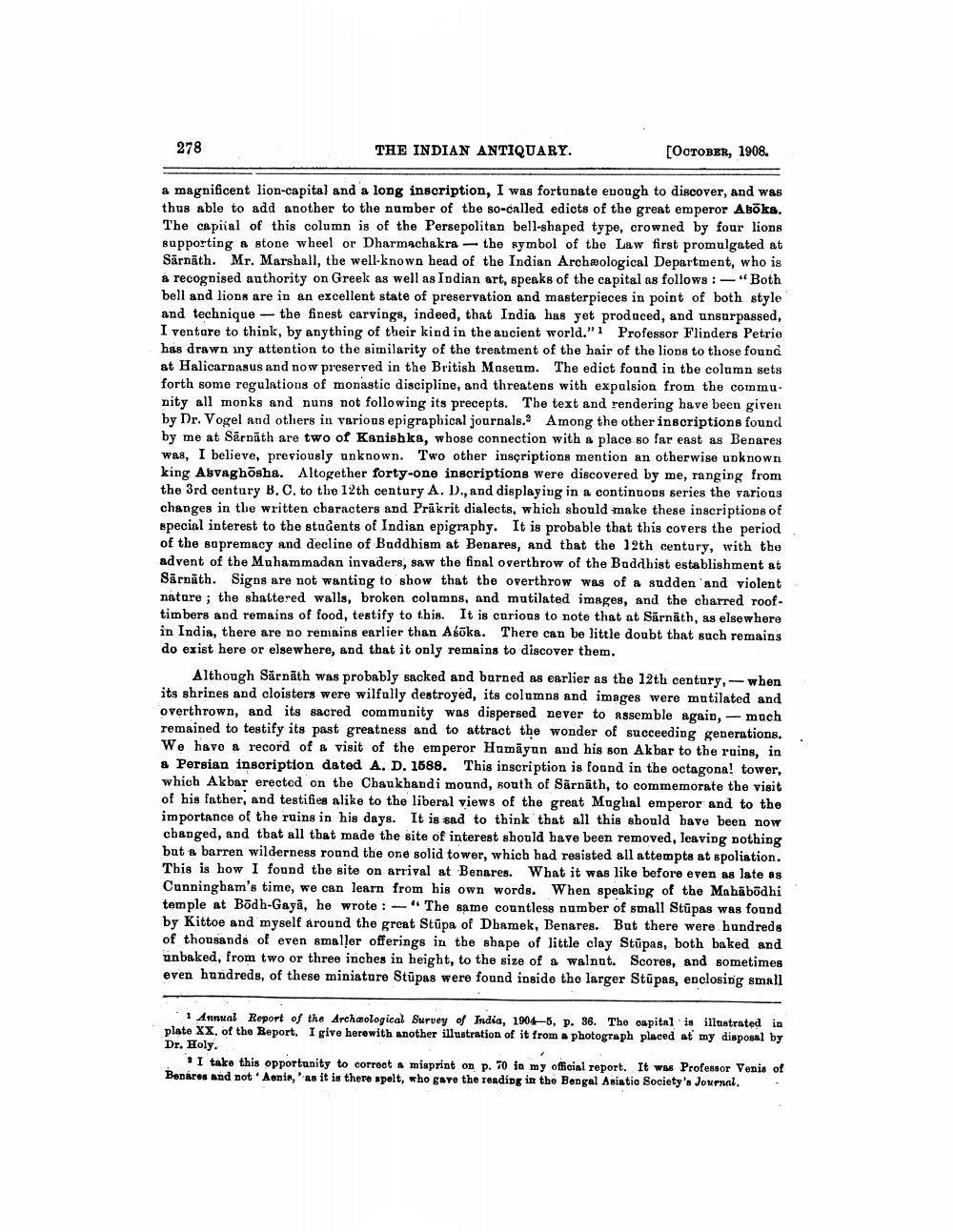________________
278
THE INDIAN ANTIQUARY.
[Остовив, 1908.
a magnificent lion-capital and a long inscription, I was fortunate enough to discover, and was thus able to add another to the number of the so-called edicts of the great emperor Asōks. The capital of this column is of the Persepolitan bell-shaped type, crowned by four lions supporting a stone wheel or Dharmachakra the symbol of the Law first promulgated at Sarnath. Mr. Marshall, the well-known head of the Indian Archæological Department, who is a recognised authority on Greek as well as Indian art, speaks of the capital as follows:- "Both bell and lions are in an excellent state of preservation and masterpieces in point of both style. and technique the finest carvings, indeed, that India has yet produced, and unsurpassed, I venture to think, by anything of their kind in the ancient world."1 Professor Flinders Petrie has drawn my attention to the similarity of the treatment of the hair of the lions to those found at Halicarnasus and now preserved in the British Museum. The edict found in the column sets forth some regulations of monastic discipline, and threatens with expulsion from the community all monks and nuns not following its precepts. The text and rendering have been given by Dr. Vogel and others in various epigraphical journals. Among the other inscriptions found by me at Sarnath are two of Kanishka, whose connection with a place so far east as Benares was, I believe, previously unknown. Two other inscriptions mention an otherwise unknown king Asvaghosha. Altogether forty-one inscriptions were discovered by me, ranging from the 3rd century B. C. to the 12th century A. I)., and displaying in a continuous series the various changes in the written characters and Prakrit dialects, which should make these inscriptions of special interest to the students of Indian epigraphy. It is probable that this covers the period of the supremacy and decline of Buddhism at Benares, and that the 12th century, with the advent of the Muhammadan invaders, saw the final overthrow of the Buddhist establishment at Sarnath. Signs are not wanting to show that the overthrow was of a sudden and violent nature; the shattered walls, broken columns, and mutilated images, and the charred rooftimbers and remains of food, testify to this. It is curious to note that at Särnäth, as elsewhere in India, there are no remains earlier than Aśoka. There can be little doubt that such remains do exist here or elsewhere, and that it only remains to discover them.
Although Sarnath was probably sacked and burned as earlier as the 12th century, when its shrines and cloisters were wilfully destroyed, its columns and images were mutilated and overthrown, and its sacred community was dispersed never to assemble again, much remained to testify its past greatness and to attract the wonder of succeeding generations. We have a record of a visit of the emperor Humayun and his son Akbar to the ruins, in a Persian inscription dated A. D. 1588. This inscription is found in the octagona! tower, which Akbar erected on the Chaukhandi mound, south of Sarnath, to commemorate the visit of his father, and testifies alike to the liberal views of the great Mughal emperor and to the importance of the ruins in his days. It is sad to think that all this should have been now changed, and that all that made the site of interest should have been removed, leaving nothing but a barren wilderness round the one solid tower, which had resisted all attempts at spoliation. This is how I found the site on arrival at Benares. What it was like before even as late as Cunningham's time, we can learn from his own words. When speaking of the Mahābōdhi temple at Bödh-Gaya, he wrote: "The same countless number of small Stupas was found by Kittoe and myself around the great Stupa of Dhamek, Benares. But there were hundreds of thousands of even smaller offerings in the shape of little clay Stupas, both baked and unbaked, from two or three inches in height, to the size of a walnut. Scores, and sometimes even hundreds, of these miniature Stupas were found inside the larger Stūpas, enclosing small
1 Annual Report of the Archaeological Survey of India, 1904-5, p. 36. The capital is illustrated in plate XX. of the Report. I give herewith another illustration of it from a photograph placed at my disposal by Dr. Holy.
I take this opportunity to correct a misprint on p. 70 in my official report. It was Professor Venis of Benares and not' Aenis, as it is there spelt, who gave the reading in the Bengal Asiatic Society's Journal.




